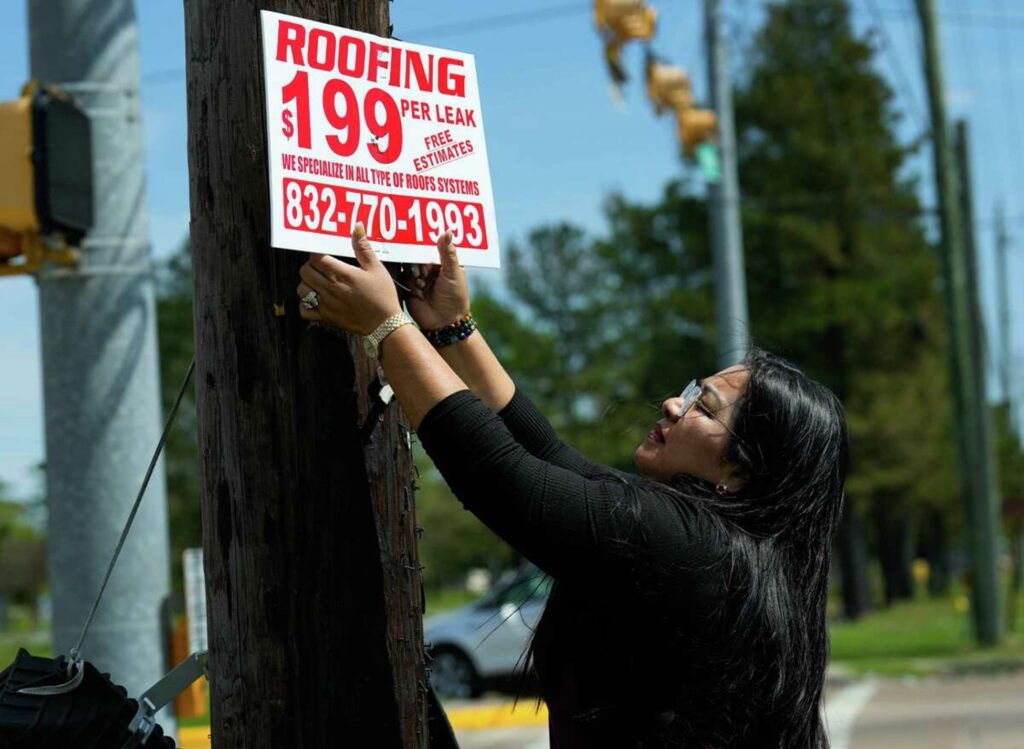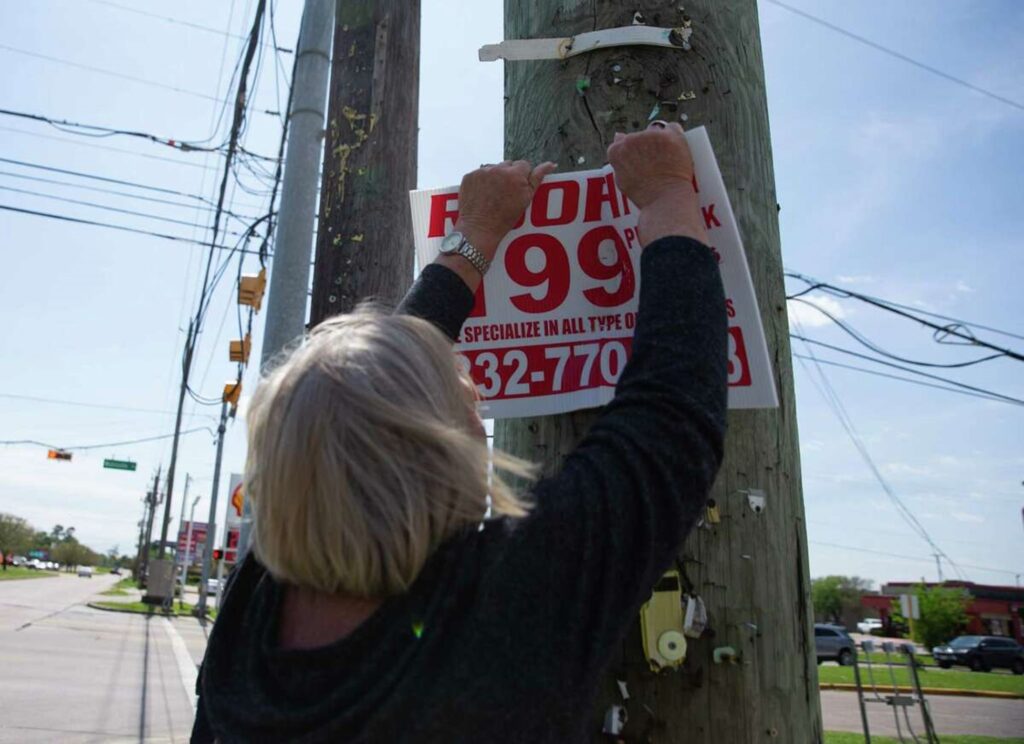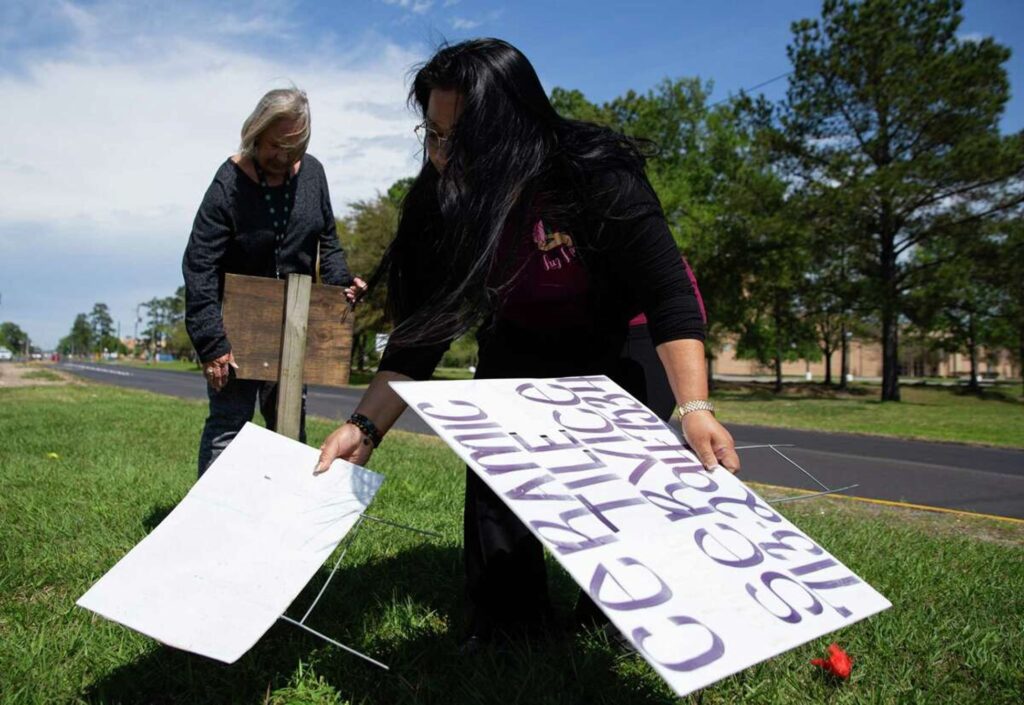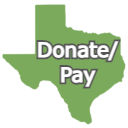Luz Lopez could see the writing on the wall, or more specifically the writing on the telephone poles and along the sidewalks and often in the medians of the busy streets in and around her Cloverleaf neighborhood.
Between the illegal dumping and the intersections cluttered with signs offering easy money, predatory loans, home sales — even offers to buy diabetic medical supplies — things were not looking good.
“At some point, if no one else is going to do it, you just have to do it yourself and you start making a difference,” she said. When it comes to so-called bandit signs and their proliferation around the Houston area and beyond, making a difference is a costly and complicated challenge for communities. Houston spends nearly $300,000 yearly yanking down illegal signs, while state lawmakers are considering increasing penalties for repeat offenders to make hanging illegal signs hurt to the point it isn’t worth it.
For Lopez, 44, doing her part means a lot of detours during her free time as she drives around the neighborhood. When she spots an illegal sign — anything in the public right of way that is advertising — she finds a place to park and takes the sign then and there, or makes a note to come back and retrieve it later.

The removals are neither vocation nor vigilantism, but fall somewhere in between. Lopez has a day job offering services from tax preparation to notary approvals and does not work for Harris County in unincorporated Cloverleaf.
“I need to get my bills paid,” she said.
Instead, she is among 246 certified “sign rangers” trained by the Harris County Attorney’s Office to spot illegal signs and address them, up to and including removing them. Becoming a ranger does not come with a badge, but it comes with a certificate and instruction for what constitutes an illegal sign, techniques for working with local businesses to educate rather than enforce and authority to remove signs in the unincorporated areas of the county when the owners will not.
Often, the businesses simply need a little coaching, said Cindy Miller, a ranger and community liaison for Harris County Precinct Two Commissioner Adrian Garcia in the Channelview area.
“Most of them do not know,” Miller said. “They are hiring someone to go out there and they’ll pay them per the sign and then they end up in the right of way.”

While Lopez and others go block by block taking signs down, lawmakers are considering ramping up the fines violators can pay. Senate Bill 190 but by Sen. Borris Miles, D-Houston, was the first bill the chamber’s transportation committee passed Wednesday, giving it ample time to move through the Capitol. No one opposed the bill during its Wednesday hearing.
Miles’ bill, identical to one filed by State Rep. Shawn Thierry, D-Houston, in the House, would raise the cap on civil penalties someone could face for erecting bandit signs. A first offense still could lead to a maximum fine of $1,000, but the second offense could lead to a fine of $2,500, followed by penalty of up to $5,000 for three or more violations. The bills also would allow authorities to seek penalties against businesses advertised on bandit signs.
Cities and counties can pursue the fines as civil penalties, meaning they take businesses or individuals to court to decide if the penalty is warranted, or settle the matter during the legal process. In Houston, most violations come with a fine of $300 to $500, less than the $1,000 allowed, which can amount to “simply the cost of doing business,” said Andrea French, executive director of Scenic Houston, which has opposed the unfettered advertising in the right of way.
Increasing fines and allowing penalties on the advertised businesses would give local officials more authority to act, and businesses less incentive to violate the law.
“Clearly, the cost is affordable and what his amendment does is make that an appropriate deterrent,” said TaKasha Francis, director of Houston’s Department of Neighborhoods.
Officials and sign rangers said the goal is to clamp down on repeat offenders and predatory businesses, not the neighborhood garage sale or church picnic.
“Big businesses are being targeted, not small,” Miles said.
Large or small, the signs are themselves a problem, city and county officials said. Along with being an eyesore in many communities where poles and medians are peppered with the signs, in the storm-battered Houston area the signs, left unattended, can block sidewalks and “end up in our drains and waterways,” French said.
The signs are particularly pervasive in neighborhoods that often are overlooked, Miles said.
“You can find a higher concentration of bandit signs in poor and minority communities,” he said. “They are blight and some promote fraudulent scams that put our communities at risk.”
Francis, who grabbed three signs in her Sunnyside neighborhood to display with her in Austin before state senators, said Houston alone spends $282,000 annually clearing the signs, with a three-person crew devoted strictly to sign removal. That trio removes 30,000 signs annually, officials said, with many others removed by various city workers, cleanup teams funded by city council members and likely many residents just fed up with the ad.

In the unincorporated county, the rangers such as Lopez do most of the work, which officials say often is less about yanking signs out of the ground and more about making connections.
“There are business owners who don’t know about the policies of the public right of way,” said Nelson Espitia, community relations director for Harris County Precinct Two. “Our first task is to educate them and then if they keep doing it, enforce.”
There generally is one exception to the immediate removal of a bandit sign: Election season, when candidates and their surrogates have a tendency to tack up signs wherever they see fit. So long as the signs are down just after election day, and they do not impede or seriously affect safety for people on sidewalks or the vision of drivers, most sign wranglers are told them to leave them alone. There is concern a ranger could target one candidate and abuse their authority.
Most of the time, when a ranger can connect with a person, the signs are removed or remedied. The general rule of thumb is signs are fine if they are behind the utility poles. If the sign is street-side of that line, they likely are illegally posted the public right of way.
That was the case last Tuesday, when Espitia, Lopez and Miller popped into a local tax preparation office. A few greetings and 90 seconds of discussion later, the office manager assured them the signs will be moved back once her husband arrived that afternoon.
“Sometimes that’s all it takes, and we’ll swing by to see they did it,” Espitia said.
Vigilance may be the most-needed trait to tackling the signs, Lopez said. She can clear an intersection of bandit signs and see more appear days later. You just tear them down again, and then again, she said.
That same willingness to work at it repeatedly is what steered Lopez into the sign ranger program. Lopez said she began noticing the nuisances around her neighborhood and just wound her way up the local political hierarchy.
“It started off because of the policing, the dumping of trash and the illegal racing,” she said. “I came to (Commissioners) Court and said ‘Are you going to come help me?’”
Those conversations led Lopez to roll up her own sleeves, and, among other things, start pulling signs off utility poles.
Sometimes they are simple to pull, other times it takes a ladder, a good pry bar or even a drill.
“My husband is a construction worker, so I have all that,” Lopez said.

